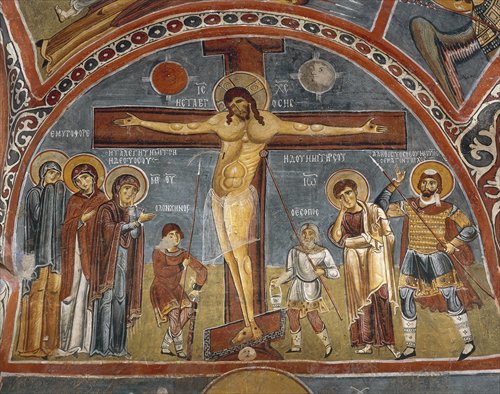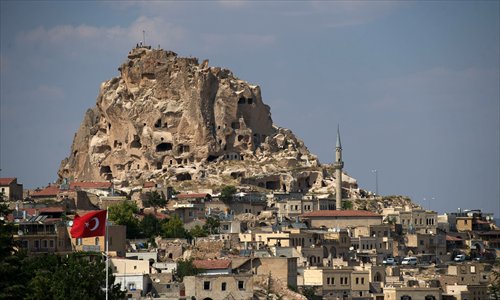HOME >> CHINA, METRO SHANGHAI
The Heart of Turkey
By Liao Fangzhou Source:Global Times Published: 2014-11-20 18:23:01
Turkey has experienced a dramatic rise in Chinese tourists since Turkish Cultural Year took place in China in 2013. The number of Chinese visitors to Turkey soared 43.3 percent year-on-year to 149,631 in the first nine months of 2014, according to Tayfun Sener, the tourism and culture counselor at the Turkish Embassy in Beijing.
One jewel in Turkey's crown is Cappadocia, an international destination along the principal trade route of the Silk Road in the heart of the country.
Mehmet Ceylan, the governor of Nevsehir Province, where Cappadocia is located, recently visited Shanghai with a 20-person delegation from the province. On November 14, they joined Ozcan Sahin, the Consul-General of Turkey in Shanghai, at a workshop that aimed to promote the province as a destination for Chinese tourists.
The region is best known for its natural wonders, beautifully preserved in the Göreme National Park and the Rock Sites of Cappadocia. This picturesque World Heritage site features minaret-like rocks called "fairy chimneys" that are one of the rarest formations of volcanic deposits in the world. "This is where you start the day with a balloon tour, in blue skies," Sahin said.
Cappadocia is almost synonymous with hot air balloon tours, thanks to ideal flying conditions and spectacular landscape - not just the fairy chimneys, but also valleys and hills, orchards and vineyards.
Balloon tours are available all year-around. A number of Chinese businesses have already sprung up in Cappadocia to provide professional photography for hot air balloon riders. "Then there is the unique opportunity to spoil yourself with trekking and nature-expose, especially in the Ihlara Valley," Sahin said. The valley is the country's most famous place for hiking due to its splendid trails and a rich wildlife.
In addition to its natural beauty, Cappadocia excels in cultural richness. Sahin said the region is full of the treasures of lost empires and antique ages that in some case stretch back millennia. For example, there are caves that were inhabited centuries ago by Christians hiding from Roman invaders. They remain one-of-the kind dwellings, monasteries, and churches.
Some of these caves are now home to modern hotels, yet another Cappadocia signature. Many of the rooms were reportedly carved at least as far back as the late 5th century, but are now fully equipped with modern facilities, blending the romance of the past and the comforts of the present.
Other must-see sights include the as many as 200 underground cities that locals built for protection and religious purposes in the Byzantine period. Although few are open to the public, sites such as the Tatlarin Underground City and the Derinkuyu Underground City offer fascinating experiences.
Ceylan told the Global Times that the region has always made a priority of protecting these natural and historical resources, and that the growing popularity of tourism in the area will not threaten their preservation.
Although basic knowledge of English will help Chinese tourists explore and enjoy Cappadocia more thoroughly, a growing number of Chinese guides have been working in the region.
To visit Cappadocia, Chinese tourists first need to fly to Istanbul. Turkish Airlines offers direct 10-hour flights from Shanghai. Visitors can then take a connecting flight to the city in the province and then catch a shuttle bus to Cappadocia.



One jewel in Turkey's crown is Cappadocia, an international destination along the principal trade route of the Silk Road in the heart of the country.
Mehmet Ceylan, the governor of Nevsehir Province, where Cappadocia is located, recently visited Shanghai with a 20-person delegation from the province. On November 14, they joined Ozcan Sahin, the Consul-General of Turkey in Shanghai, at a workshop that aimed to promote the province as a destination for Chinese tourists.
The region is best known for its natural wonders, beautifully preserved in the Göreme National Park and the Rock Sites of Cappadocia. This picturesque World Heritage site features minaret-like rocks called "fairy chimneys" that are one of the rarest formations of volcanic deposits in the world. "This is where you start the day with a balloon tour, in blue skies," Sahin said.
Cappadocia is almost synonymous with hot air balloon tours, thanks to ideal flying conditions and spectacular landscape - not just the fairy chimneys, but also valleys and hills, orchards and vineyards.
Balloon tours are available all year-around. A number of Chinese businesses have already sprung up in Cappadocia to provide professional photography for hot air balloon riders. "Then there is the unique opportunity to spoil yourself with trekking and nature-expose, especially in the Ihlara Valley," Sahin said. The valley is the country's most famous place for hiking due to its splendid trails and a rich wildlife.
In addition to its natural beauty, Cappadocia excels in cultural richness. Sahin said the region is full of the treasures of lost empires and antique ages that in some case stretch back millennia. For example, there are caves that were inhabited centuries ago by Christians hiding from Roman invaders. They remain one-of-the kind dwellings, monasteries, and churches.
Some of these caves are now home to modern hotels, yet another Cappadocia signature. Many of the rooms were reportedly carved at least as far back as the late 5th century, but are now fully equipped with modern facilities, blending the romance of the past and the comforts of the present.
Other must-see sights include the as many as 200 underground cities that locals built for protection and religious purposes in the Byzantine period. Although few are open to the public, sites such as the Tatlarin Underground City and the Derinkuyu Underground City offer fascinating experiences.
Ceylan told the Global Times that the region has always made a priority of protecting these natural and historical resources, and that the growing popularity of tourism in the area will not threaten their preservation.
Although basic knowledge of English will help Chinese tourists explore and enjoy Cappadocia more thoroughly, a growing number of Chinese guides have been working in the region.
To visit Cappadocia, Chinese tourists first need to fly to Istanbul. Turkish Airlines offers direct 10-hour flights from Shanghai. Visitors can then take a connecting flight to the city in the province and then catch a shuttle bus to Cappadocia.

Hot air balloons float above the Göreme National Park and the Rock Sites of Cappadocia, a World Heritage site.

A painting of Jesus Christ in a cave in Cappadocia.

A view of Cappadocia
Photos: CFP
Posted in: Society, Metro Shanghai